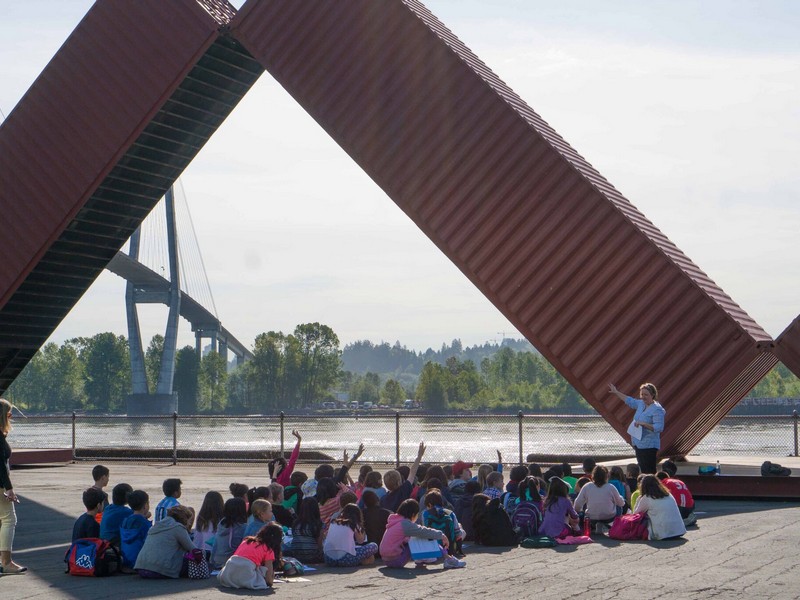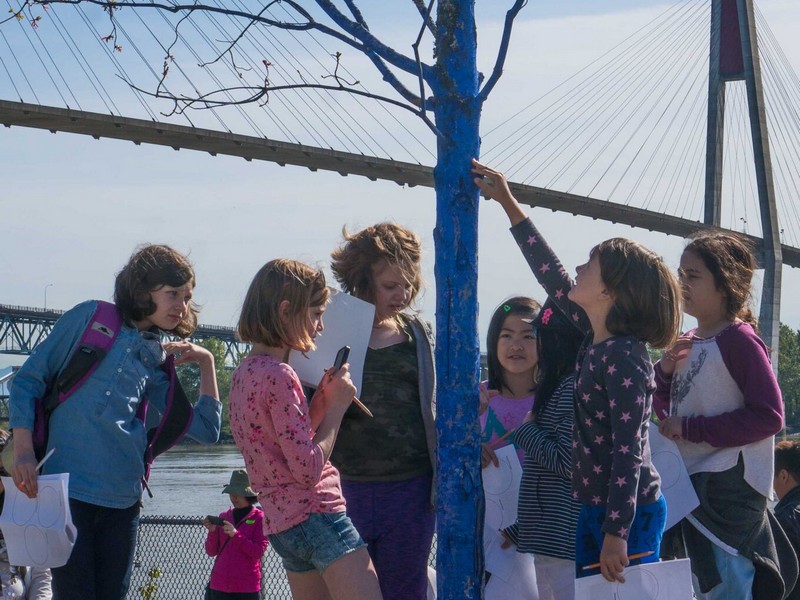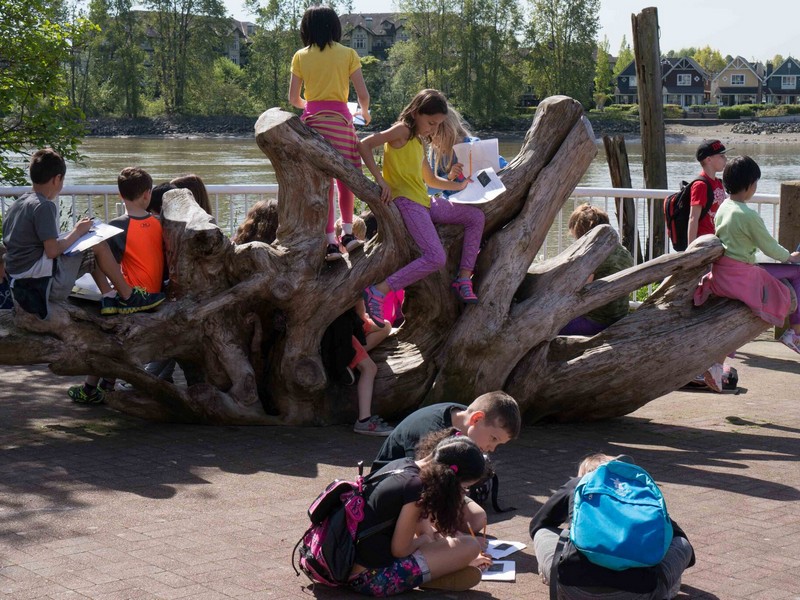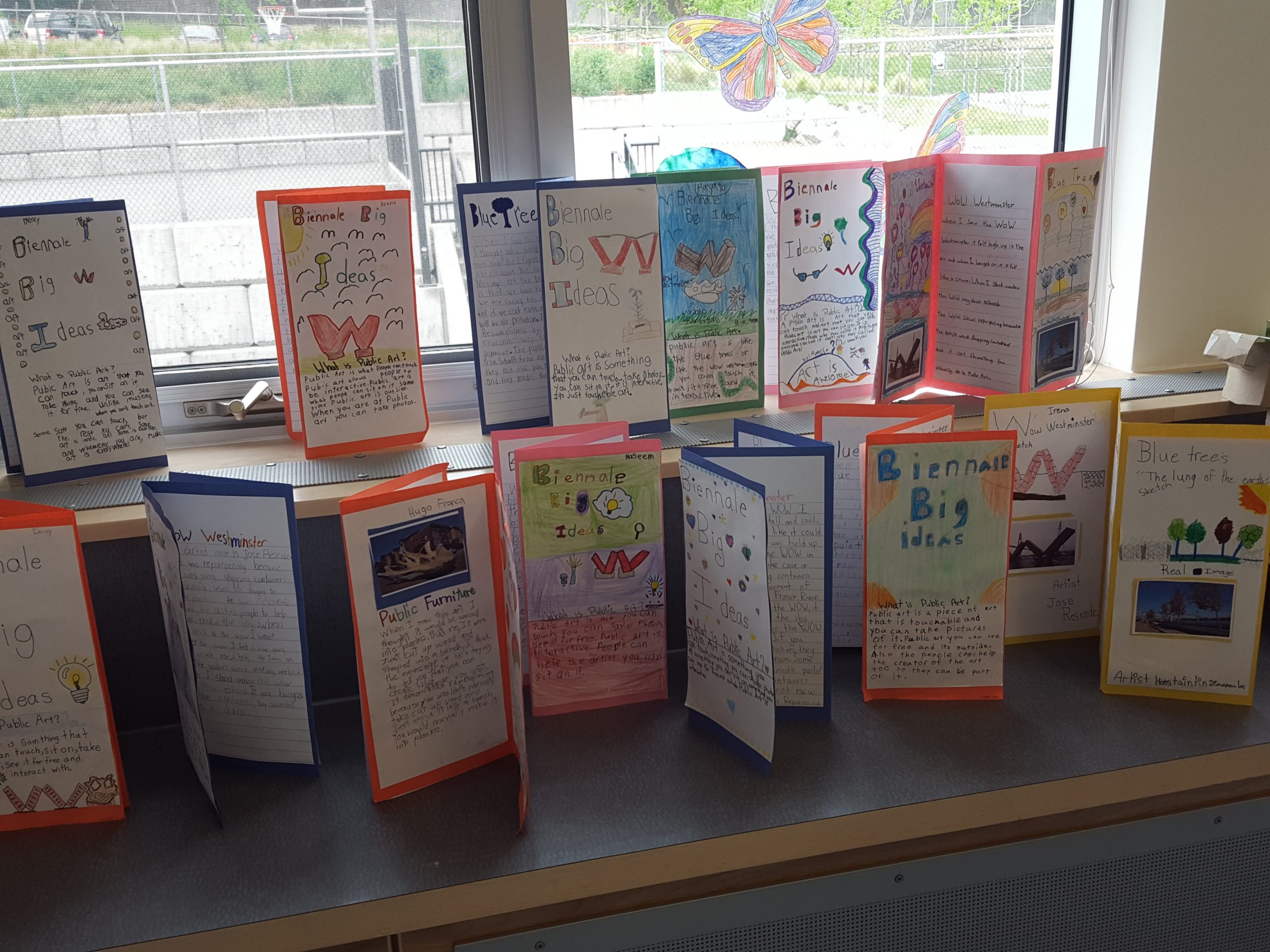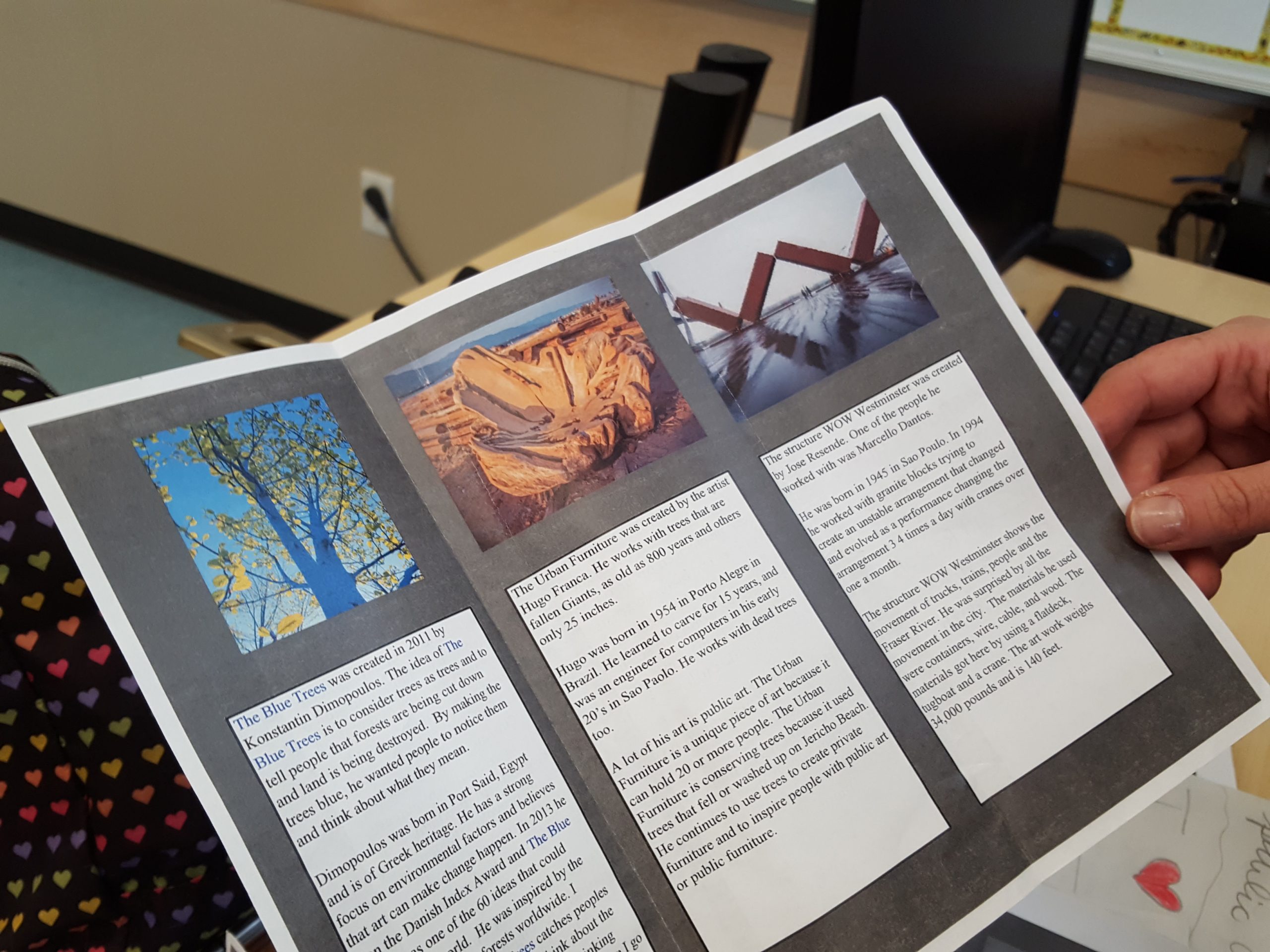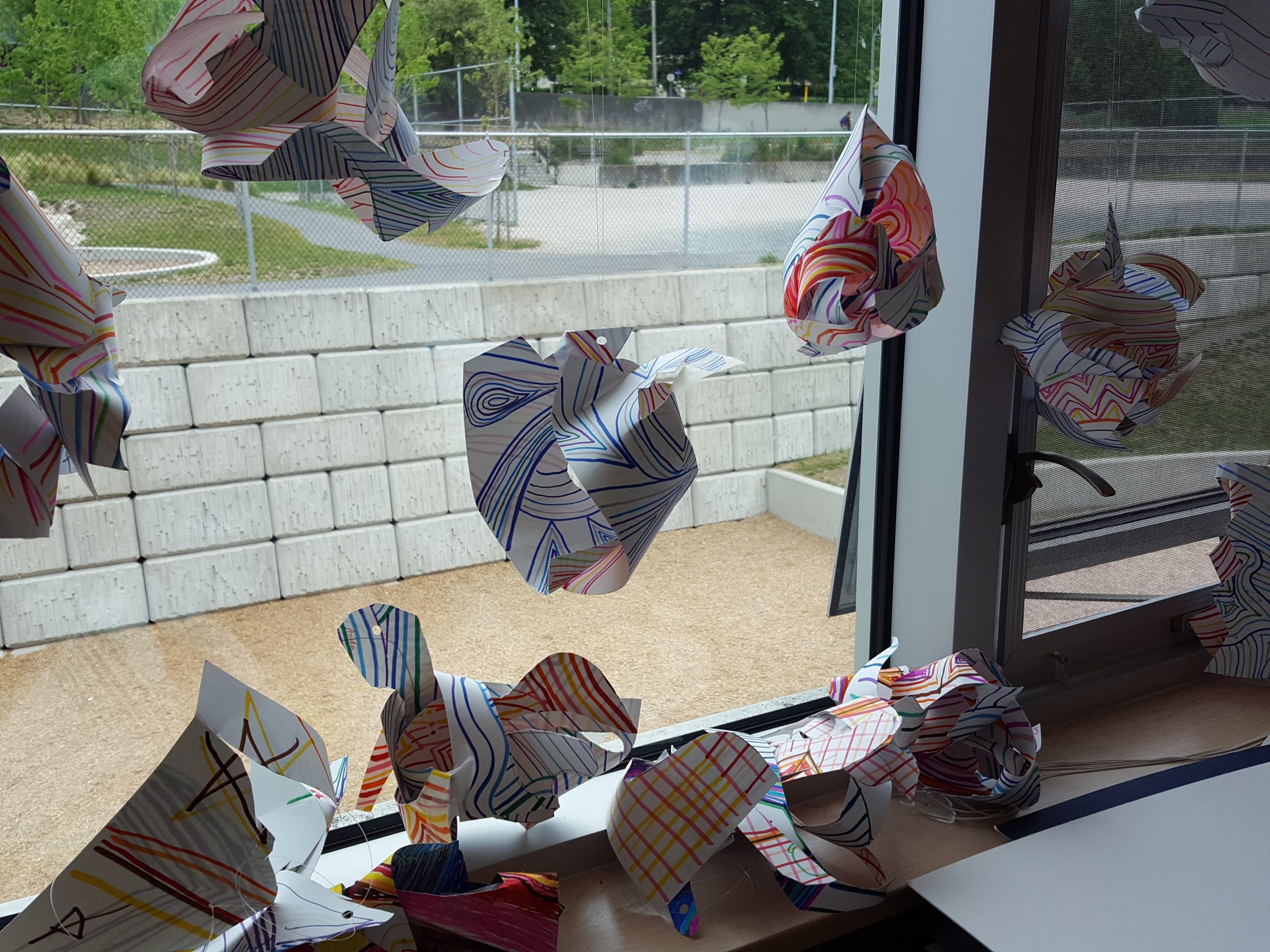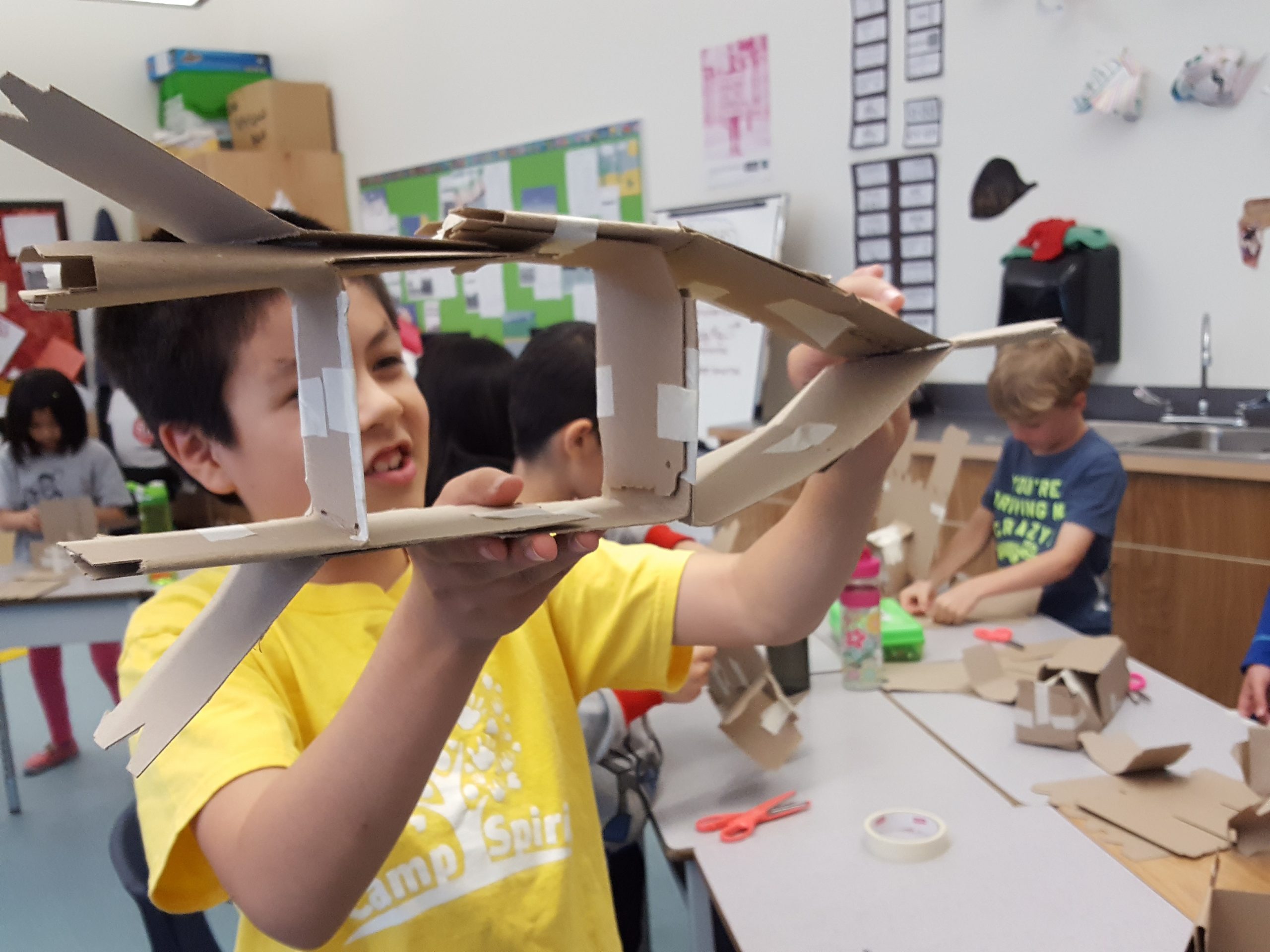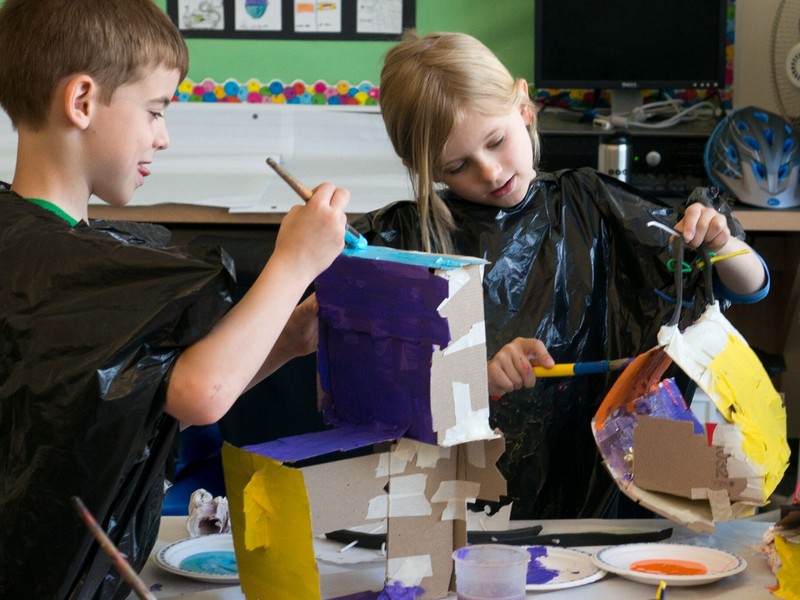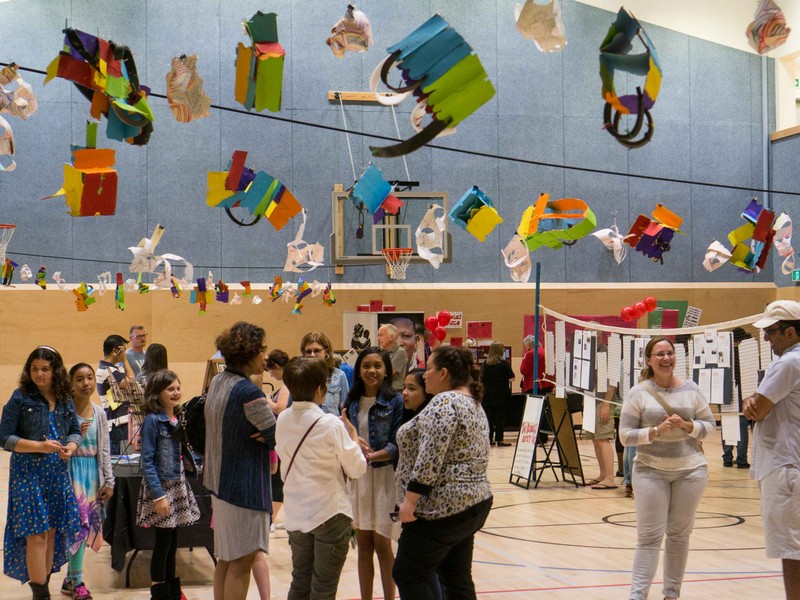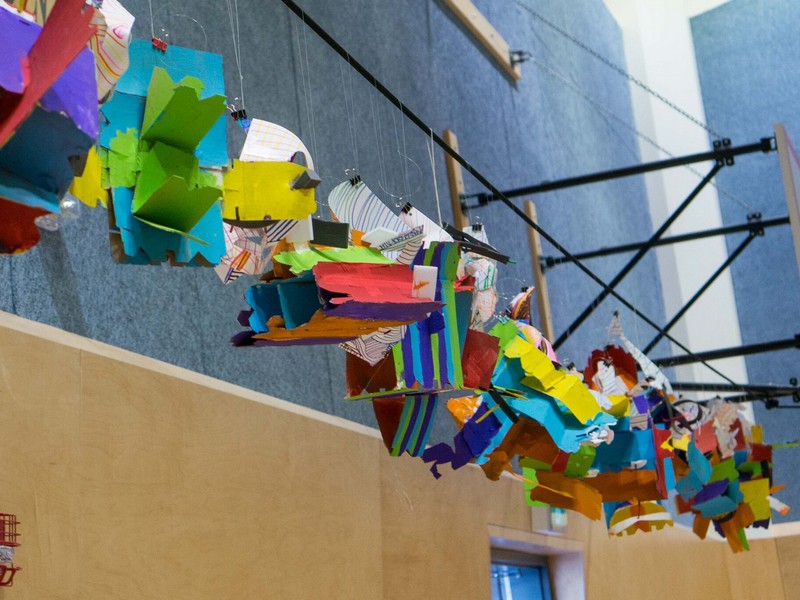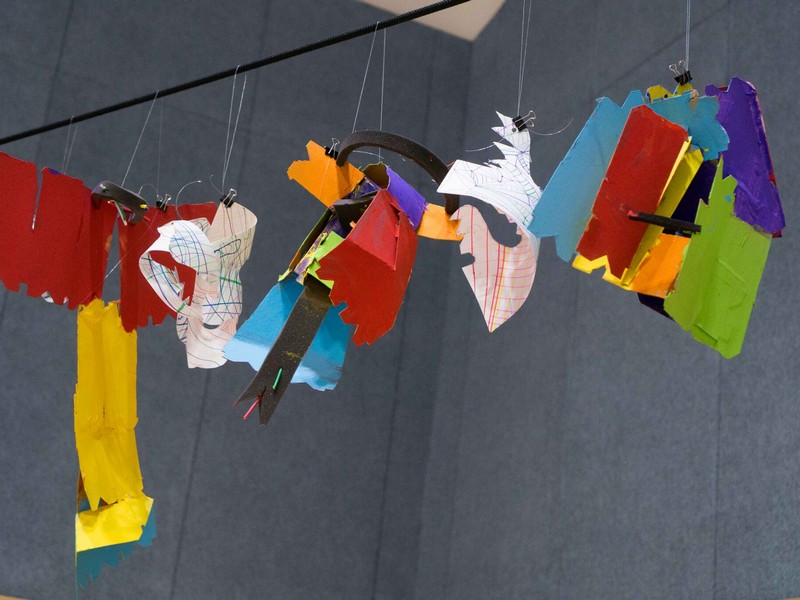École Qayqayt Elementary: Galimotos
Arts Education, Health and Career Education, Language Arts, Science, Social Studies
School: QaytQayt Elementary School
Teacher: Amy Bothwell, Sonia Maglio, Marie Stevens
Artist Collaborators: Amelia Epp
Class: Grade 3, Grade 3/4, Grade 5
Overview
In Africa, homemade galimotos are toy vehicles fashioned out of anything from sticks to cornstalks. The storybook Galimoto, by Karen Lynn Williams, served as the foundation for the exploration of this project. The concept of repurposing materials was then connected to Biennale’s installment of Public Furniture at New Westminster’s Quay and Blue Trees at New Westminster City Hall. Student understanding was further broadened in reference to repurposing materials by examining the works of Vik Muniz, a renowned artist known for his installations of art centered on reusing garbage or natural resources. Students were then invited to work with Amelia Epp, an educator who works with students to create interdisciplinary mixed media sculptures, collages and reliefs. With her guidance, students were able to explore their own creativity to demonstrate resourcefulness, repurposing and resilience through non-traditional media. Lastly, students were encouraged to find meaningful ways of transforming their new learning including working with Janine Reid, from the Stephen Lewis foundation, and organising a school wide initiative, the Red Shoe Lace Campaign, to raise awareness and funds regarding impoverished global citizens.
Connection to the Vancouver Biennale Exhibition
The teachers planned a walking field trip to see Hugo Franca’s Public Furniture/Urban Trees. This destination was chosen for its particularly meaningful location as many of the students live at Quay on the Fraser River and have probably interacted with this piece before. Students examined the piece through the lens of using a discarded tree stump to make an artistic, playful piece of furniture.
Another walking field trip was included in the project to examine the Blue Trees at New Westminster City Hall. This destination is also in the schools catchment area and some students participated in painting the trees on October 18th. The students explored the installation through the concept of a “normal” item, such as trees, being repurposed as art. Teachers challenged our student thinking by asking them how changing the position, colour, texture, size or shape of a common object transforms its message.
BIG IDEAS
Arts Education
Creative expression is a means to explore and share one’s identity within a community.
Exploring works of art exposes us to diverse values, knowledge and perspectives
English Language Arts
Exploring text and story helps us understand ourselves and make connections to others and the world
Combining different texts and ideas allows us to create new understandings
Exploring and sharing multiple perspectives extends our thinking
Social Studies
Individuals have rights and responsibilities as global citizens
Guiding Questions
How does culture influence resourcefulness and resilience?
What role does socio-economics play in this?
What are the differences between repurposing by choice vs repurposing for necessity?
What impact on the environment might repurposing have?
Cross-Curricular Access
Exploring the themes offered by the book Galimoto by Karen Lynn Williams.
Science: Recycling
What is recycling? Why is it important to recycle? Find products that have been made from recycled materials. What can you do to help the environment by recycling? What do you do already?
Social Emotional: Persistence/Determination
What is persistence? Determination? How does Kondi shows determination? Why is it good to be persistent? Is this always a good thing? It took Kondi a whole day to collect his wires and build his galimoto. How do you think Kondi felt after he finished?
Health and Well Being: Creativity/Imagination
Kondi does not have things like TV and computers or video games. What does he do with his time? What would you do if you didn’t have a TV and video games and movies? How does Kondi use his imagination? On the last page Kondi is dreaming about the toy he has made. What do you think Kondi will do tomorrow with his galimoto?
Social Studies Multi-cultural Lifestyles
Look at the pictures in the book Galimoto. How is Kondi’s life different from yours? How is it the same? Would you like to visit Kondi’s Village? Why or why not?
Inquiry Challenges
Anchor book: Galimoto, Karen Lynn Williams. Students engaged with the text over a series of guided lessons through a sequence style in which they connected, processed and transformed their thinking.
The book Galimoto was read over the course of many weeks… skills such as questioning, predicting, imaging, connecting writing in role were used to ensure a deep understanding of the text.
Extension books: Each class worked individually with a Literacy story, as a secondary text, that further required the use of creative and critical thinking and information skills to investigate and draw conclusions. Students were able to connect their learning back to Galimoto, walking field trips and art creations with Amelia Epp. This secondary text further enhanced and connected students to the Red Shoe Lace Campaign (Stephen Lewis Foundation) where students stretched their thinking to see how an ordinary item can be made extraordinary.
Learning Process
Get the Students Engaged: Introduction to Project & Big Ideas and explore the meaning of the words Repurposing, Resourcefulness, and Resilience in relation to Galimoto and to art creation through discussion and mind mapping
- Introduction: artist, her artwork, and the Vancouver Biennale Big Ideas project and the upcoming art making activities
- Creation of a collective mind map, with the words Resourcefulness, Repurposing, and Resilience at the center
- Students defined these words collectively and the ideas and definitions were recorded on a large sheet of paper to create a collective mindmap
- Discussion on the ways that these qualities are demonstrated by the protagonist in Galimoto
- Students considered how these qualities can be practiced as part of the creative process and came up with a time that they or someone they know repurposed an object or material and demonstrated resourcefulness and/or resilience
- Students created a small drawing of this example using pencil and pencil crayon
- These drawings were assembled into a class collage and displayed on the classroom wall throughout the Big Ideas project
Field Trip: Visit Vancouver Biennale Public Art on foot
Reflection: Discuss ways in which artists repurpose found/recycled materials to create art through reviewing the Vancouver Biennale public artworks in New West and viewing and discussing the work of Aurora Robson to learn about warm and cool colours and to consider techniques for creating a 3D artworks through the creation of a paper sculpture
- Students reviewed Vancouver Biennale artworks viewed on the field trip
- Students viewed images of artwork by artist Aurora Robson, discussing her use of warm and cool colours and discussed warm and cool colours
- Artist introduced the concept of “warm” colors (red, orange, yellows) and “cool” colors (blue, green, purple) by talking about the ways color can be used to express feelings and moods. Students were asked to consider questions like “What colors remind you of fire?” “What comes to mind when you think of something cold?”
- Students will each be given a white piece of card stock to create patterns with markers using warm colours on one side and cool colours on the other side
- for younger grades, Amelia or teacher will draw lines on paper for students to cut out their strips of paper for assembly into a sculpture
Art Inquiry: Complete the Hanging Sculptures by reviewing sculpture-building techniques learned in previous session
- Students used knowledge of 3D sculpture and warm and cool colours to design and create a hanging sculpture using cardboard, masking tape, wire, and foam and add colour to the sculptures using acrylic paint. The class reviewed and discussed the use of warm and cool colours and reviewed sculpture-building techniques learned in previous session.
- Students titled their sculptures based on the meanings they want to convey through their artworks.
- Students wrote about how they practiced resourcefulness, resilience, and repurposing in creating their sculptures
- Students wrote words that they associate with each other’s sculptures to create ‘found poems’
- Artist discussed with students how abstract shapes/lines/forms/textures can be used to convey feeling, emotion, action, etc.
Student Creation
Students worked with Amelia Epp to explore the idea of transforming recycled materials into playful pieces. The ideas of “deconstructing” and “repurposing” sculptures as a parallel to children building works of art from non-traditional, engaging media.
Upon return of the field trip two divisions made brochures for the three Biennale installations they visited and one division made postcards for each of the installations.
Janine Reid, a member of the Royal City Gogos, one of a network of 250 groups across Canada that fundraise for African grandmothers caring for children orphaned by AIDS. Royal City Gogos direct their funds to the Stephen Lewis Foundation that partners with community-based agencies in 15 African countries. As a friend and educator who has travelled to Swaziland to meet the families on the front lines in the struggle against HIV/AIDS in Africa, she offered her firsthand account of the spirit, ingenuity and perseverance she witnessed. As an option for a transforming project, students under Janine’s guidance led a fundraiser entitled the Red Shoelace Campaign, whereby students showcase the many uses a of simple red shoelace and then sell them with profits to the Stephen Lewis Foundation.
The oldest class, Grade fives, finished with a write comparing resourcefulness, resilience, and reproposing as compared in first and third world countries.
To end the project, a public celebration where the school invited the community in to our school gymnasium and have our student’s artwork on display. Student ambassadors would speak to the process they experienced and share their key learning.
Reflection
Grade 3 Teacher – Sonia Maglio
We enjoyed how this project empowered students. They connected with our story and fully engaged in the process. They truly became reflective on how some parts of the world are affected by poverty and whole heartedly wanted to make a difference. Being able to connect Biennale with the Royal City GOGOS was a wonderful way to connect the students from a fictional story to real life people. The creative process was undeniable one of the most engaging pieces of the Biennale Process. Students were given the opportunity to create art as a means to showcase the process of repurposing from found objects as a means of creative art work (first world repurposing), and compare their process to that of Third World repurposing out of necessity. We really enjoyed delving in to the different realms of art and looking at the meaning and message that the public art pieces conveyed. This was a fabulous project with so much depth and creativity. One that will forever remain as a highlight of our teaching careers.
Artist – Amelia Epp
It worked very well to visit the classrooms for the first time after the students had read the book Galimoto. The themes of this story tied in very nicely to the Vancouver Biennale sculptures and to the art making process. The three key words that the teachers had highlighted from the book – repurposing, resourcefulness, and resilience – provided a strong thread throughout the entire sequence of activities. The teachers were able to source very interesting recycled materials for the art projects which also tied in very nicely to the story of Galimoto, the Vancouver Biennale sculptures, and the three key words.
I would have liked to have had more time to explore the individual artists who created the Vancouver Biennale sculptures with the students. It also would have been interesting to spend more time learning about each of the individual sculptures. Additionally, there are many other artists that we could have discussed, time permitting (i.e. Vik Muniz, El Anatsui, etc.). Because of time constraints, we only discussed the work of Aurora Robson, in addition to the three Vancouver Biennale sculptures. These works tied together well and provided strong links to the three key words.
The collaboration process with the teachers was really effective and enjoyable. They worked on the projects with the students in between my visits and continued to refer back to Galimoto and to the Vancouver Biennale field trip. Because the teachers did this work between visits the students were more easily able to make connections between aspects of the project during my visits to the classroom.
Credits
Photos at the WOW Westminster, Blue Trees, Public Furniture | Urban Tree and student art exhibition by Amelia Epp
